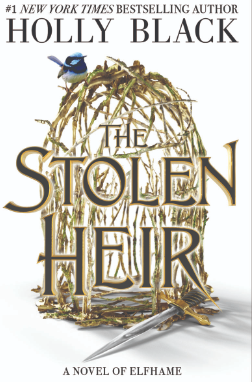When choosing a fantasy book as a young adult, readers can be caught in a trap of recycled tropes and flat characters. The books available all boast the same garbage plot and simple protagonists with obvious goals. Not so with Holly Black’s latest novel in the Elfhame universe, The Stolen Heir.
As any reader of Cruel Prince can confirm, Holly Black’s writing is a work of art. The Stolen Heir builds upon the world of The Cruel Prince from a new perspective, adding intricate layers to the plot of the trilogy while creating a book more astounding than her last.
Amid the overflowing options of fantasy, Black’s characters and intense description set her apart, but the world-building of Elfhame truly pushes her work to the top. Faerieland, home of the Folk, is seen not as a 2-dimensional Disney movie with magical dust and colorful creatures, but as the place described in mythology. As she reminds readers, “All of Faerie is beautiful like this, with carnage hidden just beneath.” (Black, 90)
The protagonist, Suren, had her fate sealed in The Queen of Nothing. To understand her story, reading the first three is a must. However, Suren’s journey in the Stolen Heir occurs eight years after the battle where she was introduced, a child ruling the Court of Teeth as her cruel parents’ puppet. Depicted as a creepy ice queen with a secretive backstory, Black revealed very little of her mysterious past.
As her story progresses, Wren falls for Oak, but she decides her feelings could be a weakness. “With him,” she says, “I am forever a night-blooming flower, attracted and repelled by the heat of the sun.” (Black, 351) Black’s writing, evident in this line alone, is purposeful, ripe with deep description, and it sucks the viewer in, manipulating their emotions the way only great books can. Every line she adds is important, every choice filling the gaps of the trilogy by building to the plot twists and foreshadowing the layers each character possesses.
Black allows readers to search for the morality most protagonists are held to, but pulls the influence of mortal justice from Elfhame. The characters themselves are far from human. She twists the story to display the best and worst of each person. Wren even calls herself a monster, saying,“I couldn’t stop being afraid of myself. Afraid of the monster I saw when I glimpsed my reflection in still pools, in windows…” (Black, 343)
In the end, however, she grows into her wickedness.“I feel the sharpness of my teeth and roll my tongue over them. For the first time,” she says, “I like the feeling.” (Black, 348) Suren and the others have no cause for the black-and-white morals we expect of them, becoming deeper, more realistic figures because of it. Their world gains a lifelike quality as a result.
In an oversaturated genre, Suren’s story is raw and rich, pulling apart the basic elements of every story to question them. Black shatters the genre’s stereotypes, and turning the last page feels as though one has finished a fat slice of cake, full but left unsatisfied. Black sculpts a dark, powerful, dangerous world. While we glimpsed Jude’s perspective, the mortal foster daughter of the High General in the trilogy, Stolen Heir reveals a new side entirely. Readers won’t regret continuing to explore Elfhame, but will be left craving Black’s writing, more addicting than any Everapple could be.



